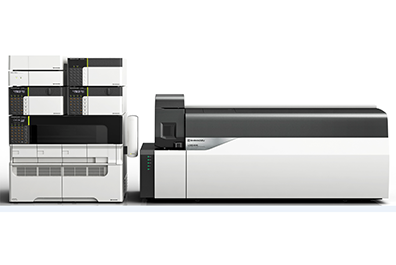LCMS-8045 LC-MS/MS

The triple quadrupole LCMS-8045 is the workhorse instrument in the Shimadzu LC-MS/MS lineup, designed to be analyzing samples around the clock. The heated ESI probe, high-temperature heating block, heated desolvation line, drying gas, and focusing optics all act to maximize sensitivity while minimizing contamination. This means continuous operation in the laboratory with reliable data collection, even for complex matrices like biological fluids or foods.

No longer sacrifice sensitivity for robustness
Instrument Detection Limits (IDL)
Instrument Detection Limit is one measure of sensitivity for analytical instrumentation. The chromatograms to the right show the IDL for Reserpine and Chloramphenicol, obtained using ESI+ and ESI-, respectively. The IDL for Reserpine is 2.03 femtograms and 2.09 femtograms for Chloramphenicol.
Shimadzu's mass spectrometry interface includes a high-sensitivity heated ESI source, heated capillary sample introduction, and proprietary ion transfer optics. These design features combine to produce robust mass spec performance. As shown below, 12,000 plasma samples were injected over 25 days (over 480 samples per day). Picogram levels of alprazolam were analyzed with an RSD of 3.42%.
Easy maintenance, high-quality data, and reduced run times
The Heated ESI Probe
Designed without cables or tubes, removing the new ionization unit is simple: release a one-touch lever to open the unit and lift it out. In addition, no tools are needed to detach the needles fitted in APCI and DUIS units, allowing for easy maintenance.
Ultra-Fast, Ultra-Sensitive
Equipped with a heated ESI probe, the triple quad LCMS-8045 delivers the sensitivity and reproducibility needed in the production laboratory. Furthermore, the instrument is capable of providing accurate and stable data over long periods of time. With the inclusion of Shimadzu's ultra-fast technologies, like UFscanning, which enables the world's fastest scan speed of 30,000 u/s, and UFswitching, which allows for a 5 ms polarity switching time, production laboratories gain significant advantages. These include reduced run times for increased throughput and shortened method development time. With the new state-of-the-art heated ESI probe, desolvation efficiency improves trace detection and quantitation. This probe combines high-temperature air gas with a nitrogen nebulizer spray, assisting in the desolvation of large droplets and facilitating ionization.
